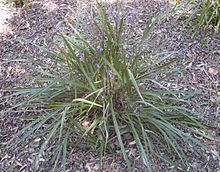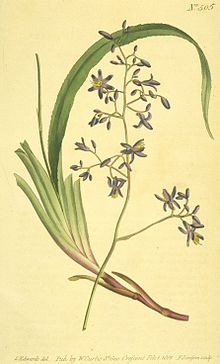- Dianella caerulea
-
Dianella caerulea 
flowers, Mount Archer National Park, Rockhampton Scientific classification 
Kingdom: Plantae clade: Angiosperms clade: Monocots Order: Asparagales Family: Xanthorrhoeaceae Subfamily: Hemerocallidoideae Genus: Dianella Species: D. caerulea Binomial name Dianella caerulea
Sims [1]Dianella caerulea, commonly known as the Blue flax-lily, blueberry lily,[2] or paroo lily,[3] is a perennial herb of the family Xanthorrhoeaceae, subfamily Hemerocallidoideae, found across the eastern states of Australia and Tasmania. It is a herbaceous strappy perennial plant to a metre high, with dark green blade-like leaves to 70 cm long. Blue flowers in spring and summer are followed by indigo-coloured berries. It adapts readily to cultivation and is commonly seen in Australian gardens and amenities plantings.
Contents
Taxonomy
It was first described by English taxonomist John Sims in Curtis's Botanical Magazine in 1802. Its specific name is the Latin adjective caerulea "blue".[4] The genus name is derived from the Roman goddess Diana, with a diminutive suffix -ella.[3]
Dianella caerulea is highly variable species, with many forms found throughout eastern Australia.[3] Six varieties are known from the Sydney district alone.[5]
The species is described as having seven varieties, having been revised by Queensland botanist Rod Henderson in 1987 for the Flora of Australia:
- Dianella caerulea var. assera grows as a taller solitary tufted plant to 1.8 m high, and is found from Nowra north along the New South Wales coast and Blue Mountains into Queensland.[6]
- Dianella caerulea var. caerulea
- Dianella caerulea var. cinerascens is a pale-grey leaved form to 0.8 m inland and north of the Sydney basin, from Putty northwest to Wollar.[7]
- Dianella caerulea var. petasmatodes is a more mat-forming variant, which reaches 2 m in diameter and 1.3 m high. It is found on the far north coast of New South Wales into Queensland.[8]
- Dianella caerulea var. producta is a taller variety to 1.3 m found from Nowra and Blackheath north through New SOuth Wales and into Queensland. It has a greenish white to blue perianth.[9]
- Dianella caerulea var. protensa is a smaller variant up to 0.5 m high, which grows as a solitary tuft. It is found from Nowra northwards through New South Wales into Queensland. It is found in sclerophyll forest on sandy soils.[10]
- Dianella caerulea var. vannata is a taller variant to 1.3 m recorded from the Blue Mountains, the far north coast of New South Wales and Queensland.[11]
Description
Dianella caerulea is a strappy herbaceous fruit bearing plant to about 1 metre (3 ft) high, with a thick spreading rhizome under the ground. The bright green leaves have straight or toothed margins, and may reach 75 cm (30 in) in length and 0.3-2.5 cm wide. The small (1-1.6 cm diameter) flowers bloom in spring and summer (August to January); the perianth is pale to a dark blue, or green-blue, and the anthers at the centre are yellowy brown. These are followed by small roughly spherical indigo-coloured berries which range from about 0.7 to 1.2 cm (0.3-0.5 in) in diameter.[12] These fruit are edible.
Distribution and habitat
The plant is distributed through a range in Victoria, New South Wales, Tasmania, and Queensland. It occurs in a wide range of habitats, from coastal heathland and even sand dunes.[3]
Cultivation
Believed to have been first propagated in England in 1783, Dianella caerulea is commonly cultivated in gardens, and is sometimes seen as a low-hedging plant in public spaces and amenities plantings. It is very hardy and long-lived, and suitable for rockeries.[3] It is tolerant of poor drainage and responds well to extra moisture. Plants attract fruit-eating birds and butterflies in garden settings.[13] The smaller denser forms in particular have potential for small gardens.[14]
Plant Hardiness
Dianella caerulea is a very hardy (snow and frost hardy) and long-lived plant once established. It can tolerate damp conditions but prefers moist well drained soil. It adapts readily to cultivation.[15]
References
- ^ IPNI: Phormiaceae Dianella caerulea Sims Bot. Mag. 15: t. 505. 1801
- ^ "Dianella caerulea". Australian Plant Name Index (APNI), IBIS database. Centre for Plant Biodiversity Research, Australian Government. http://www.anbg.gov.au/cgi-bin/apni?taxon_id=46172.
- ^ a b c d e Eliot RW, Jones DL, Blake T (1984). Encyclopaedia of Australian Plants Suitable for Cultivation: Volume 3. Port Melbourne: Lothian Press. p. 259. ISBN 0-85091-167-2.
- ^ Simpson DP (1979). Cassell's Latin Dictionary (5 ed.). London: Cassell Ltd.. ISBN 0-304-52257-0.
- ^ Fairley A, Moore P (2000). Native Plants of the Sydney District: An Identification Guide (2nd ed.). Kenthurst, NSW: Kangaroo Press. p. 361. ISBN 0-7318-1031-7.
- ^ Wilson, K. L.. "Dianella caerulea var. assera R.J.F.Hend.". PlantNET - NSW Flora Online. Royal Botanic Gardens & Domain Trust, Sydney. http://plantnet.rbgsyd.nsw.gov.au/cgi-bin/NSWfl.pl?page=nswfl&lvl=in&name=Dianella~caerulea~var.+assera. Retrieved 2009-10-10.
- ^ Wilson, K. L.. "Dianella caerulea var. cinerascens R.J.F.Hend.". PlantNET - NSW Flora Online. Royal Botanic Gardens & Domain Trust, Sydney. http://plantnet.rbgsyd.nsw.gov.au/cgi-bin/NSWfl.pl?page=nswfl&lvl=in&name=Dianella~caerulea~var.+cinerascens. Retrieved 2009-10-10.
- ^ Wilson, K. L.. "Dianella caerulea var. petasmatodes R.J.F.Hend.". PlantNET - NSW Flora Online. Royal Botanic Gardens & Domain Trust, Sydney. http://plantnet.rbgsyd.nsw.gov.au/cgi-bin/NSWfl.pl?page=nswfl&lvl=in&name=Dianella~caerulea~var.+petasmatodes. Retrieved 2009-10-10.
- ^ Wilson, K. L.. "Dianella caerulea var. producta R.J.F.Hend.". PlantNET - NSW Flora Online. Royal Botanic Gardens & Domain Trust, Sydney. http://plantnet.rbgsyd.nsw.gov.au/cgi-bin/NSWfl.pl?page=nswfl&lvl=in&name=Dianella~caerulea~var.+producta. Retrieved 2009-10-10.
- ^ Wilson, K. L.. "Dianella caerulea var. protensa R.J.F.Hend.". PlantNET - NSW Flora Online. Royal Botanic Gardens & Domain Trust, Sydney. http://plantnet.rbgsyd.nsw.gov.au/cgi-bin/NSWfl.pl?page=nswfl&lvl=in&name=Dianella~caerulea~var.+protensa. Retrieved 2009-10-10.
- ^ Wilson, K. L.. "Dianella caerulea var. vannata R.J.F.Hend.". PlantNET - NSW Flora Online. Royal Botanic Gardens & Domain Trust, Sydney. http://plantnet.rbgsyd.nsw.gov.au/cgi-bin/NSWfl.pl?page=nswfl&lvl=in&name=Dianella~caerulea~var.+vannata. Retrieved 2009-10-10.
- ^ Wilson, K. L. (1999). "Dianella caerulea Sims". PlantNET - New South Wales Flora Online. Royal Botanic Gardens & Domain Trust, Sydney. http://plantnet.rbgsyd.nsw.gov.au/cgi-bin/NSWfl.pl?page=nswfl&lvl=sp&name=Dianella~caerulea. Retrieved 2009-10-09.
- ^ Elliot, Rodger (1994). Attracting Wildlife to Your Garden. Port Melbourne, Victoria: Lothian. pp. 39. ISBN 0-85091-628-3.
- ^ Thompson, Paul (2002). Australian Planting Design. Port Melbourne, Victoria: Lothian. pp. 144. ISBN 0-7344-0438-7.
- ^ http://fruitandnuttrees.com/blue-flax-lily-blueberry-lily
External links
 Works related to Curtis's Botanical Magazine 15:505 Dianella Cærulea at Wikisource
Works related to Curtis's Botanical Magazine 15:505 Dianella Cærulea at Wikisource  Media related to Dianella caerulea at Wikimedia CommonsCategories:
Media related to Dianella caerulea at Wikimedia CommonsCategories:- Asparagales of Australia
- Hemerocallidoideae.
- Flora of New South Wales
- Flora of Queensland
- Flora of Tasmania
- Flora of Victoria (Australia)
- Fruit and Nut Trees
Wikimedia Foundation. 2010.


